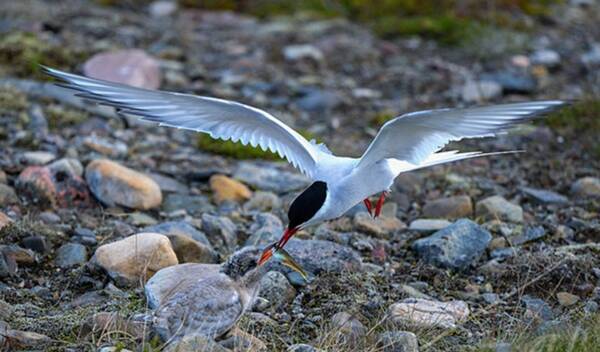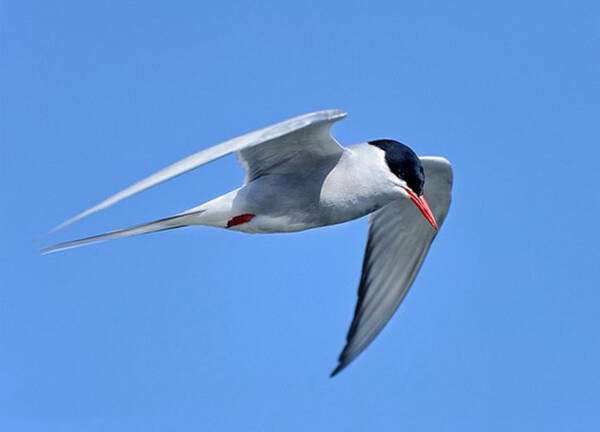Sterna paradisaea
IUCN
LCBasic Information
Scientific classification
- name:Sterna paradisaea
- Scientific Name:Arctic Tern ,Sterna paradisaea
- Outline:Wading birds
- Family:Charadriiformes Laridae Tern
Vital signs
- length:33-39cm
- Weight:80-120g
- lifetime:20-33years
Feature
It has a "black cover" on its head and is the bird that flies the farthest on Earth.
Distribution and Habitat
The Arctic tern is a migratory bird found in and around the Arctic. It inhabits swamps, coasts, and other areas. During the breeding season, it mainly inhabits coasts, island rocks, and sandy land. During the non-breeding season, it mainly inhabits the open ocean.
Appearance
The Arctic tern has mainly grey and white plumage, with a red beak and legs, a white forehead, black top of the head and nape, and white cheeks. Its grey wings are 305 mm long, with brown shoulder feathers. The upper wings are grey with white feather edges, the neck is pure white, and the forked tail with grey feathers is also the same. The ear coverts behind are black.
Details
The Arctic tern is a seabird belonging to the tern genus. It is medium-sized and distributed in the Arctic and nearby areas. It is a migratory bird. It experiences two summers each year, migrating from its northern breeding area to the ocean near Antarctica, and then migrating back to the breeding area. The entire journey is more than 40,000 kilometers, which is the longest migration route among known animals.

The Arctic tern is a light seabird that can fly long distances. When it is summer in the northern hemisphere, Arctic terns breed in the Arctic Circle. They fly low over the waves, catching small fish and hard-shelled animals such as crustaceans from the sea for food. When winter comes and the water along the coast freezes, the terns set out on a long-distance migration. They fly south, cross the equator, circle halfway around the earth, and arrive in the icy Antarctic, where they enjoy the summer in the southern hemisphere. It is not until winter in the southern hemisphere that they fly north again and return to the Arctic. They travel back and forth between the two poles once a year, covering tens of thousands of kilometers.
Among all migratory animals, the Arctic tern's ability to travel long distances is rare. In summer, they move from the Arctic Circle in Canada to Massachusetts in the United States. In winter, they will fly to another polar region, the South Pole, to overwinter. The tail of the tern is forked, and its wings are narrow and long. This pair of wings has much greater buoyancy than other birds when flying in the air.

Every March, the Arctic terns, who have been visiting Antarctica for several months, gather in small groups and prepare to go north for an ultra-long-distance journey, flying about 18,000 kilometers on the way to return to their breeding grounds in the Arctic. Before the expedition, they must completely shed their old feathers and replace them with brand new feathers. They will start from the Antarctic Peninsula, fly to southern Africa, cross the mountains, continue northward through the tropical region, fly along the coast of West Africa to the European continent, and finally fly to the Arctic to settle down. Starting from the late summer in Antarctica, they fly to the Arctic just at the beginning of summer. Arctic terns enjoy the long sunshine time, which no other animal can compare with. After completing the longest migration of all animals on the earth, they set up camp in the Arctic in early May and begin a new breeding cycle.
Arctic terns often move in groups. They fly over the sea for a long time and frequently, and constantly skim the water to catch food. Arctic terns not only have extraordinary flying ability, but also are aggressive and brave. Although they often quarrel and fight among their neighbors, they will immediately put aside their past grudges and unite to face the invasion of foreign enemies. In fact, they often gather in large groups of tens of thousands for collective defense. Arctic terns are smart and brave, and they always gather in large groups of tens of thousands for collective defense. Minks and foxes like to steal Arctic tern eggs and chicks, but in front of such a powerful camp, they have to think twice before acting. Even the most powerful polar bears are afraid of them.

Arctic terns mainly feed on aquarium/52-marine-animals.html">marine animals such as fish, crustaceans and cephalopods. They mainly forage on the sea surface. The food varies with the region and time, but they are usually carnivorous, mostly eating small fish or aquatic crustaceans. Fish occupy an extremely important position in their diet. The fish they eat include herring, cod, sand eel and smelt, while the aquatic crustaceans include crabs and krill. Sometimes they also eat mollusks, aquatic insects or berries, and in the northern breeding areas, they also eat insects.
The breeding season of the Arctic Terns is from June to July. At this time, female terns often beg male terns for food, and the frequency of male terns' response is regarded by female terns as a measure of his ability to be a father. At the beginning of the breeding season, male terns fly over the nesting areas with light wings, showing themselves to mates. Each screaming bird holds a freshly caught fish in its blood-red beak, hoping to attract the attention of the female bird that has not yet mated.

The Arctic Terns are considered threatened and of concern by some countries. They are also listed as one of the species in the Agreement on the Conservation of African-Eurasian Migratory Waterbirds (AEWA). In New England, Arctic Terns were hunted to near extinction in the late 19th century for millinery. The number of Arctic Terns in western Greenland has been declining dramatically since 1950, and some hunting operations are still ongoing. In the south, the number of Arctic terns is also declining, and the main reason is food shortage.
BirdLife International believes that the number of Arctic terns has gradually stabilized since 1988, with about 1,000,000 Arctic terns in the world. The species has a wide distribution range and is not close to the vulnerable and endangered threshold standard for species survival (distribution area or fluctuation range less than 20,000 square kilometers, habitat quality, population size, and distribution area fragmentation). The population trend is stable, so it is evaluated as a species without survival crisis.
Listed in the IUCN Red List of Threatened Species in 2018 ver 3.1 - Least Concern (LC).
Related reports
Although humans are the most intelligent creatures and have built very modern airplanes, it is by no means easy to travel back and forth between the two poles. Therefore, the spirit and courage of the terns who are not afraid of hardships and pursue light are particularly worth learning. Because they always spend their days in the summer at the poles, and the sun never sets in the summer at the poles, so they are the only creatures on earth that live in light forever.
Not only that, they also have very tenacious vitality. In 1970, someone caught a tern with a ring on its leg, and it was found that the ring was put on in 1936. In other words, this Arctic tern has lived for at least 34 years. Therefore, it must have flown at least 1.5 million kilometers in its lifetime. People have tracked and studied Arctic terns and found that they can live for more than 33 years, and a lifespan of 20 years is probably quite common.








